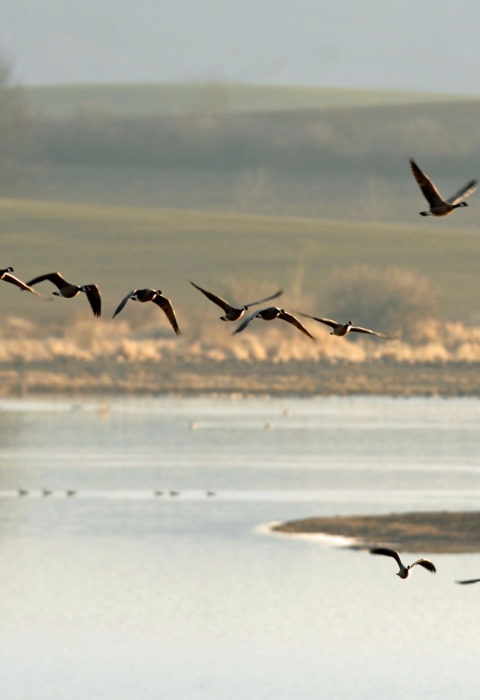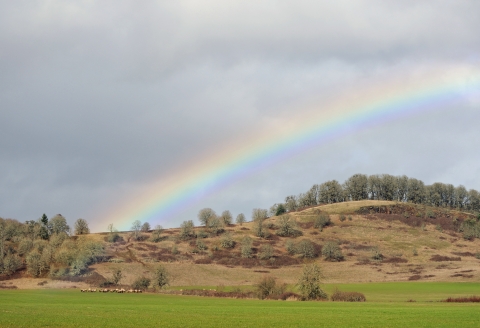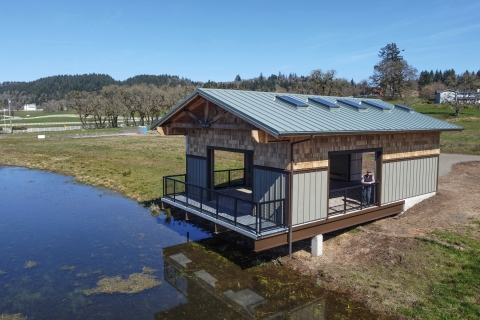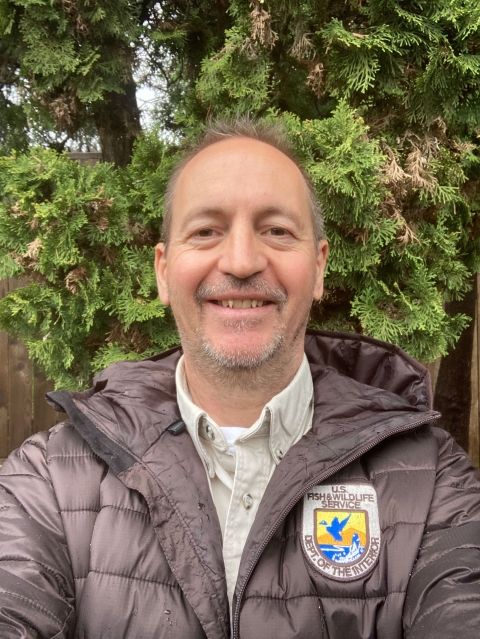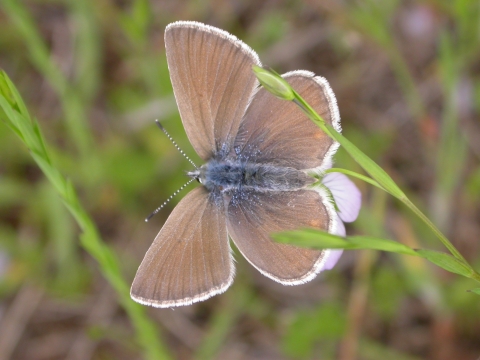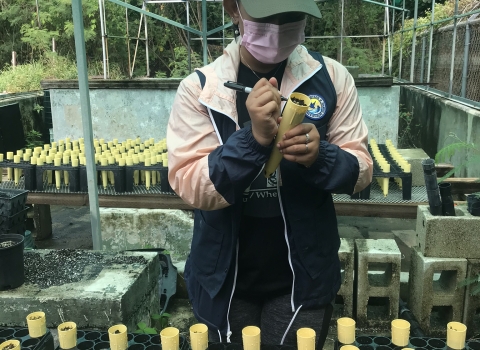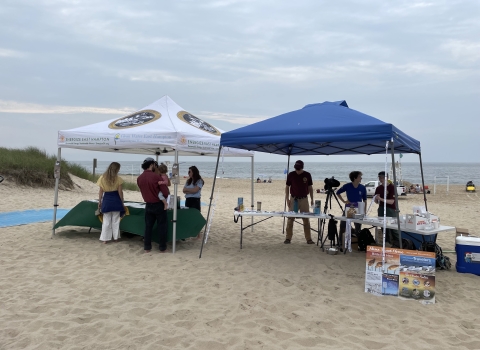When you ask Damien Miller what he loves most about his work in the Willamette Valley, he says it’s working with dedicated staff, partners and landowners to conserve, restore, and protect conservation lands and wildlife habitat.
The Willamette Valley is the green, beating heart of Oregon. From Portland south to Eugene, 70% of Oregon’s population lives in the valley and it is home to agriculture, recreation and conservation.
The Willamette Valley National Wildlife Refuge Complex is at the center of those conservation efforts, including, from north to south, Baskett Slough, Ankeny, and William L. Finley refuges. They provide a place for wildlife and plants, and they are also recovering endangered species, protecting the clean water sources on which people of the valley rely, and providing inclusive opportunities for all people to enjoy their natural world.
Miller has been the person responsible for overseeing those refuges for the past 12 years, he has been working with Tribes, communities, partners, and neighbors to conserve the heart of Oregon. He was recently recognized by the Department of Interior with their highest career honor, the Distinguished Service Award.
The citation read, “Mr. Miller is a leader in conserving Trust resources and engaging communities on behalf of recognized the U.S. Fish & Wildlife Service, the Department of the Interior, and the National Wildlife Refuge System. Mr. Miller’s collaborative work with the Service and our partners on endangered species recovery within the Willamette Valley contributed to delisting four species including the endemic Oregon chub, the first fish species to be recovered in U.S. history.
“Mr. Miller spearheaded a lengthy land protection planning effort involving multiple partners including the Confederated Tribes of the Grand Ronde, that culminated with the establishment of the Willamette Valley Conservation Area. His efforts will ultimately protect an additional 22,650 acres of important oak and prairie habitat (of which less than 10% remains) for the American people. Mr. Miller’s leadership and creativity in fostering multiple conservation partnerships both on refuge system lands and beyond the boundaries using the Partners for Fish and Wildlife and Visitor Services programs has been essential to not only the ESA recovery and land protection efforts, but also connecting people with nature. These partnerships include collaborating with the Natural Resource Conservation Service and Oregon Department of Fish & Wildlife to restore prairie and wetland habitats on nearly 15,000 acres of private land.
“Mr. Miller also partnered with a nonprofit environmental organization to design and build the multimillion-dollar Ankeny Hill Nature Center at Ankeny National Wildlife Refuge. Through this ongoing partnership, he created an education center and community anchor that is advancing our mutual conservation mission. Mr. Miller also provided leadership in establishing a bilingual outdoor education program enables the Service to directly engage Spanish-speaking communities in the Willamette Valley. Using innovative and exciting educational programming, Mr. Miller nurtured this pioneering effort that is connecting people with nature and establishing the Service as a community asset to the diverse cultures in the area. For his outstanding contributions to species recovery, sustaining partnerships, and expanding land protection and community engagement for the Service and the Nation, Damien Miller is granted the highest honor of the Department of the Interior, the Distinguished Service Award.”
Miller took a few moments to chat with me about his career, the award, and the future of conservation in the Willamette Valley.
Q: What do you love about your work in the Willamette Valley?
A: What I love most about working here is the dedication, enthusiasm, and camaraderie of the conservation community working collaboratively to conserve, protect, and restore natural habitats for the benefit of fish, wildlife, and the American people for generations to come.
Q: What do you see as the most important work we can do to conserve species for the future?
A: Each species has unique habitat requirements. When you evaluate habitat requirement for species that are declining or endangered, you’ll often find that the amount and quality of habitat is in decline due to loss from land conversion, fragmentation, or encroachment of invasive species invasive species
An invasive species is any plant or animal that has spread or been introduced into a new area where they are, or could, cause harm to the environment, economy, or human, animal, or plant health. Their unwelcome presence can destroy ecosystems and cost millions of dollars.
Learn more about invasive species . This loss is accelerating in some areas due to climate change climate change
Climate change includes both global warming driven by human-induced emissions of greenhouse gases and the resulting large-scale shifts in weather patterns. Though there have been previous periods of climatic change, since the mid-20th century humans have had an unprecedented impact on Earth's climate system and caused change on a global scale.
Learn more about climate change and land use changes so from my perspective the most important thing we can do to conserve species in decline and at risk for extinction is to protect their remaining habitat from conversion, and work toward conservation and restoration of high-quality natural habitat.
Q: Why is protecting habitat in the Willamette Valley so important?
A: Over 90% of the native oak and prairie habitat in the Willamette Valley has been converted to other land uses. Many native, Willamette Valley species rely on these habitat types for their continued existence. Protecting, conserving, and restoring high-quality habitat will provide a sustainable, functional and resilient landscape to ensure all the diverse species found here will endure.
Q: Can you tell me about the partners and private landowners you work with and why they are essential for conservation?
We work closely with a long list of conservation partners. As just one example, we’ve been working with the Willamette Valley Oak and Prairie Cooperative, comprised of more than 40 conservation organizations, agencies and Tribes, working to protect key oak and prairie habitat. Their effort helped guide and support the Service’s recent Land Protection Plan for the Willamette Valley.
Our Partners for Fish and Wildlife staff have been working with landowners and organizations here for over 20 years. Our collaborative partnership with Oregon Department of Fish and Wildlife and the Natural Resource Conservation Service has been instrumental in restoring and protecting thousands of acres of key wetland and prairie habitat and recovering endangered species. We also collaborate with the Springfield-Eugene based Rivers to Ridges Partnership of 19 organizations working to protect and restore open space in the southern Willamette Valley, and we have a close working relationship with the Salem Audubon Society and our Friends of Willamette Valley National Wildlife Refuge Complex working to build and manage the bilingual nature center on Ankeny National Wildlife Refuge.
Our team of 25 highly motivated and dedicated staff with specialties including administrative work, equipment operation, prescribed fire, law enforcement, public engagement/outreach, biology and land restoration/management create and maintain these partnerships and ensure we accomplish our conservation mission. We are also blessed with very dedicated volunteers working countless hours in support of our common goals.
No one organization can accomplish this greater vision alone, but working collaboratively and leveraging our strengths and resources, cumulatively we are making significant progress toward this greater vision.
Q: What led you to your career with the Service?
A: I grew up on a farm in Minnesota with a father who was an outdoor enthusiast, hunter, fisherman and conservationist at heart. He instilled in me a love for nature at a young age, which I pursued with a bachelor’s and master’s degree in wildlife management. I’ve had a lifelong desire to conserve and manage land, habitat and advance conservation of fish and wildlife habitat. I worked for two state agencies, a nonprofit conservation organization and the private sector prior to having an opportunity to join what I consider to be our nation’s premiere fish and wildlife conservation organization.
Q: What does this Distinguished Service Award mean to you?
A: I’ve been with the Service for 22 years and am rewarded each day with the knowledge that I’m making a positive difference in a mission that I truly believe in. When I first heard about my nomination for this award it was really hard to believe and incredibly humbling. I count my blessing each day for such a great job, a great team, amazing partnerships and such meaningful work, and I never expected recognition for it. To be nominated by my colleagues and recognized nationally with such a prestigious award fills me with gratitude, appreciation and is an incredible honor.
